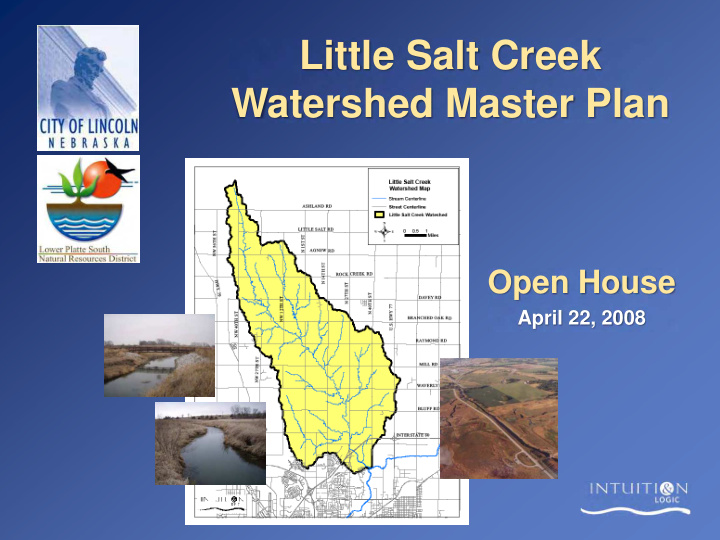



Little Salt Creek Watershed Master Plan Open House April 22, 2008
Open House Format • Formal Presentation (15 minutes) • Informal Stations Following Formal Presentation – Visit with Project Team Staff – Ask Specific Questions
Tonight's Agenda • Introduction • Purpose of Watershed Master Plan • Study Goals and Objectives • Information Stations
Lincoln Watershed Management/ NRD Partnership • Minimize Flood Damage • Control Erosion & Sedimentation • Preserve Watershed Resources – Water Quality – Stream Stability – Riparian Habitat • Encourage Sustainable Growth …Ensuring Quality of Life for Future Generations
Watershed Master Planning • City/NRD Planning Effort • Watershed Master Plans Completed – Beal Slough – SE Upper Salt Creek – Steven’s Creek – Cardwell Branch – Deadman’s Run • Overall Goals – Unified Master Plan – Integrate Public Input
Little Salt Creek Watershed Master Plan Goals & Objectives Goal - Develop long-term planning tools and improvement projects to address water quality, flood management, and stream stability and provide guidance for sustainable urban growth in the watershed Study Objectives • Maintain a Proactive Stakeholder and Public Involvement process • Update Floodplain and Floodway Maps • Identify Flooding, Erosion, and/or Water Quality Problems • Consider Critical Habitat and Rare or Sensitive Environmental Resources • Develop Guidelines and Recommendations for Future Development • Identify Potential Funding Sources for Future Studies and/or Projects
Little Salt Creek Watershed Master Plan Major Study Components Public Involvement Watershed Floodplain Inventory Mapping Watershed Natural Master Plan Stream Stability Resources Soil Water Quality Assessment
Project Team Team Leaders Engineering Consulting Team Heartland Center for Leadership Development Other Agency Team Members Lincoln Lancaster County Planning Department
Public Involvement • Open House • Newsletters • Website www.lincoln.ne.gov Keyword “watershed” • Citizen Advisory Committee (CAC)
Citizen Advisory Committee • David Grimes • Gene Petersen • Gary Hellerich • David Potter • Don Helmuth • Harold Roper • Chris Helzer • Dave Sands • Larry Hudkins • John Schleich • Merle Jahde • Vicky Wheeler • Susan Kuck • Mark Whitehead • Jack Nagel
Watershed Inventory • Collect, Compile, and Evaluate Existing Watershed Data • Geographic Information System Format (GIS) • Study Data Collected in GIS Format
Floodplain Mapping • Last Updated in Early 1980s • Develop Maps Using Latest Technology – Computer Models – GIS Format Output
Stream Stability • Geomorphic Data Collection • Stream Characteristics • Identify Potential Future Stream Characteristics
Natural Resources • Agriculture – Cropland – Pasture – Native Prairie • Environmental – Tiger Beetle – Saline Wetlands USDA – Saltwort • Streams/Waterways
Water Quality • Stream Bioassessments • Water Quality Assessment
Soil Assessment • Identification of Dispersive Soils • Field Sampling and Laboratory Testing • Identify Apparent Seeps in Stream Banks
Little Salt Creek Watershed Master Plan Project Timeline 2008 2009 TASKS Feb Mar Apr May June July Aug Sept Oct Nov Dec Jan Feb Mar Apr May June July Aug Sept Oct Nov Floodplain Mapping Data Gathering & Analysis Master Plan Report Development Open Houses 1�More�Open�House Citizen Advisory 2�More�CAC�Meetings Committee Meetings
Information Stations • Five Information Stations 1. Public Involvement 2. GIS 3. Floodplain Mapping 4. Stream Stability 5. Natural Resources • Visit with Project Team Staff • Ask Questions • Comment Cards
Recommend
More recommend